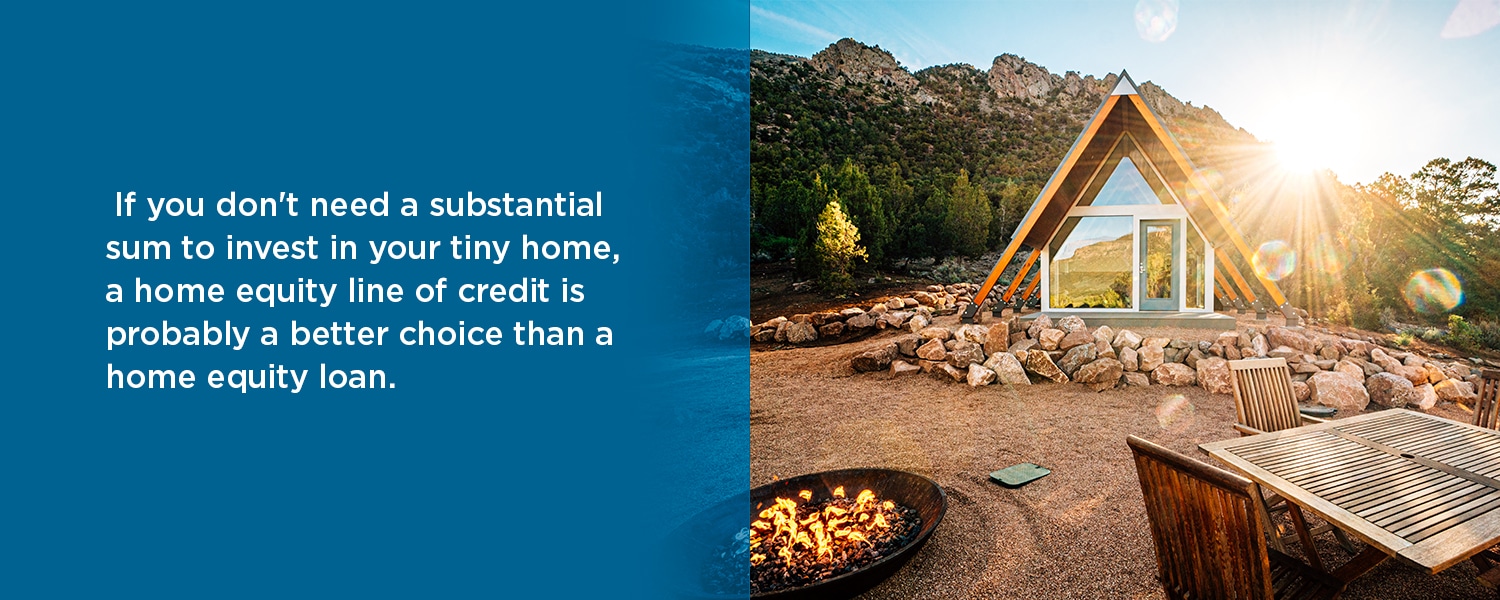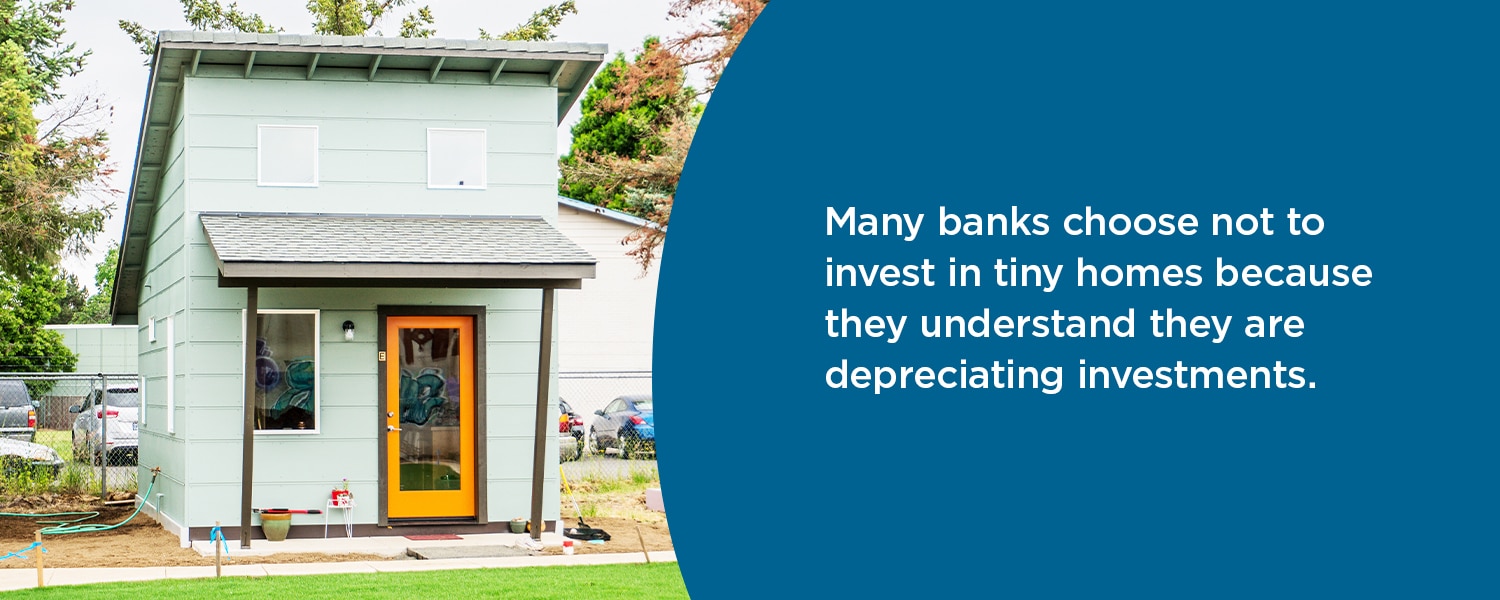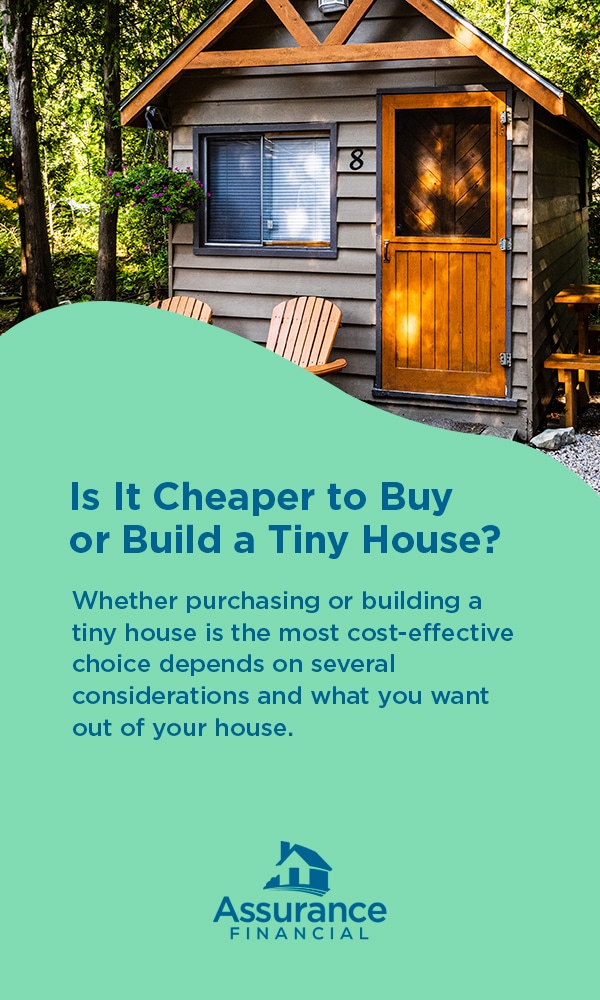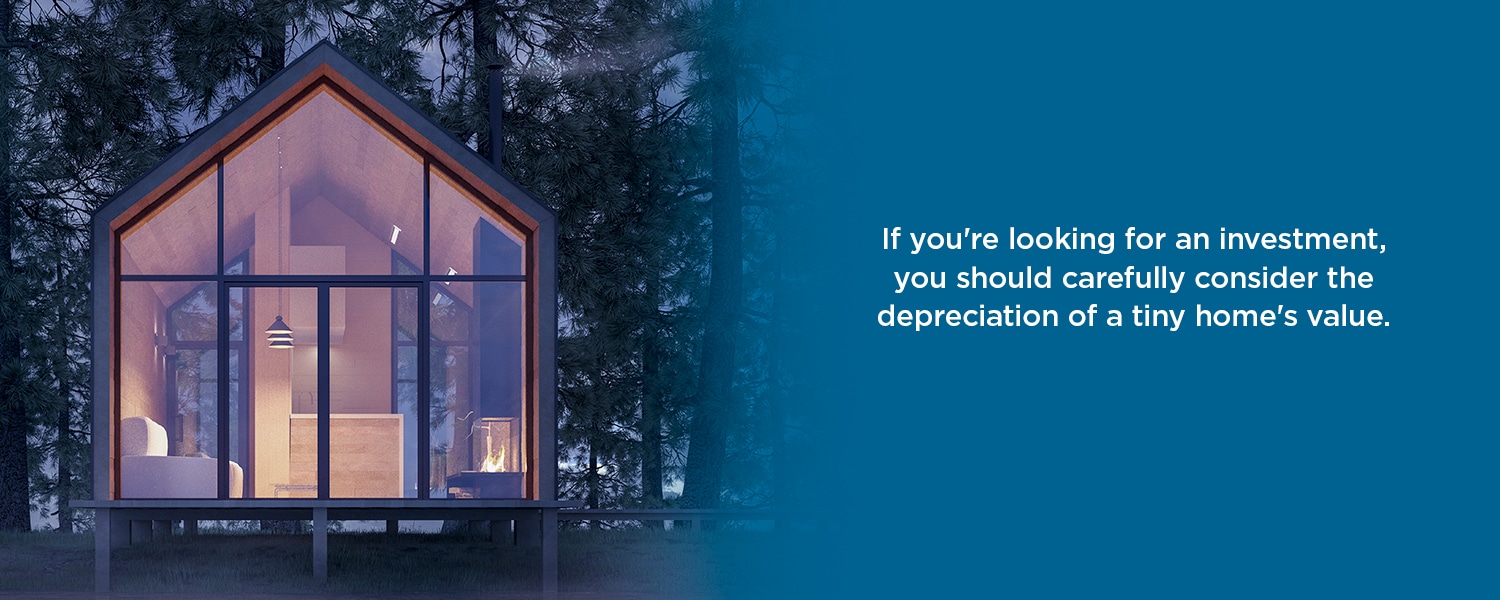Tiny houses are beloved for their cozy atmosphere, affordability, and mobility — with a tiny home, you can travel anywhere you dream. At 400 square feet or less, tiny houses are great for downsizing and finding out what really fulfills you in life. Whether you’re looking to take all the comforts of home on the road with you or you’re hoping to downsize and reduce your carbon footprint responsibly, joining the tiny house movement can be quite a worthwhile investment.
However, tiny houses can come with big challenges for financing since their small size makes them ineligible for many mortgage and insurance plans. From finding the right mortgage to finding a legal place to store your home, you must understand the unique financial demands of a tiny house and prepare for challenges ahead of time. Get ahead of the game and learn how to finance your tiny home with Assurance Financial.
Topics Covered
- What Qualifies as a Tiny Home?
- How to Finance a Tiny Home Build
- What Are the Challenges to Financing a Tiny House?
- How Long Can You Finance a Tiny House?
- Is It Cheaper to Buy or Build a Tiny House?
- Do Tiny Homes Depreciate?
- How Much Are Tiny Homes Worth?
What Qualifies as a Tiny Home?
Any home that’s under 400 square footage is considered a tiny home. Tiny homes have gained traction in the past decade as a pushback against the growing square footage and rampant financial appreciation of larger family-sized homes. Tiny homes allow their owners to save more money and work less, all while getting to customize their own unique living space. Today, thousands of people live in tiny homes both on and off the grid, and many people even take their tiny houses with them on the road.
There are two main types of tiny homes — those on wheels and those on foundations. Tiny houses on wheels (THOW) operate like a trailer and allow easy transportation and setup almost anywhere with the right access points. For insurance and financing purposes, THOWs fall under the umbrella of recreational vehicles (RVs) and covered as such. THOWs also come with many additional financial considerations, like parking fees, water bills, electricity costs and transportation costs.
Compared to THOW, tiny houses on foundations are easier to mortgage and insure. Mortgage companies only cover buildings on foundations since they are more protected from the elements. However, tiny homes on a foundation may come with additional costs due to the size of the lot they reside on and other property taxes.
The options for tiny house usage are endless. Tiny houses are perfect for people just starting their home-owning journey, those looking to downsize, those in retirement and those who want to live while traveling on the road. Many purchase tiny houses to be accessory dwelling units for parents, in-laws, in-home caregivers and adult children looking for an affordable place to stay. Tiny homes are also an affordable option for those looking to build an office or small business location in their existing yard.
How to Finance a Tiny Home Build
Tiny homes aren’t subject to the same financing, mortgage and insurance rules as traditional home loans. The average tiny home can cost buyers anywhere between $30,000 and $100,000 depending on the size, make and material of the tiny home, which means adequate financing is still a high priority. Financing and insuring a tiny home requires working with banks and lenders who may work exclusively with tiny homes and understand the unique challenges they bring to the table.
While many go into the tiny home buying process to lessen their debt, many buyers still need comprehensive financing packages to create or purchase their dream tiny home. With the backing of a major bank or credit union, you can finance your tiny home for up to 20 years for the promise of smaller monthly payments. Comparatively, many RV loans also allow you to finance THOWs.
Here are some of the best ways to finance a tiny house:
Traditional Mortgages
If you want to finance your tiny home with a traditional mortgage, it needs to be on a solid foundation on a plot of land. However, it can be pretty difficult to get a traditional mortgage on a tiny home. Traditional mortgages are usually only an achievable means of funding for those with large tiny homes on a foundation or those with expensive, luxury tiny houses with price points close to a traditional home.
Land Loans
Since many tiny homes don’t come with a plot of land, you may need to consider a land loan. Land loans operate similar to mortgages but have larger down payments and interest rates due to the lack of property collateral. To qualify for a land loan, you must have a great credit score and a significant portion of the total cost saved as a down payment. You must also have a detailed land development plan to convince lenders that you’re a good investment.
Construction Loans
If you’re building your own tiny home from the ground up, you may be eligible for a short-term construction loan that covers the cost of your customized tiny house. Construction loans are designed to help homeowners get started on building a custom home to then use a mortgage to pay off the home once it’s been completed. This method is one potential hack for those seeking a traditional mortgage who would otherwise be unable to secure one.
Tiny House Builders and Lenders
Many tiny house builders offer their own financing and lending programs, so you don’t have to complicate the financing process and go through anyone else. Today, there are hundreds of tiny house contractors to choose from located in every state. When you opt to finance your build through a tiny house building company, you’ll get to customize every square foot of your home while receiving financing.
Home Equity Loans
If you already own a home and are looking to add a new private tiny home space to your land, you may be able to tap into your existing home equity to get what you need. This strategy is perfect for those building additional living quarters or offices. Home equity loan amounts are determined by subtracting the amount of money you currently owe on your mortgage from your total property’s value. The more of your home you’ve paid off, the more you can tap into your home equity.
Home Equity Lines of Credit
While a home equity loan is ideal for those looking for a lump sum at a fixed interest rate, those looking to draw money as they need it should apply for a home equity line of credit instead. Home equity lines of credit frequently come with an adjustable interest rate and allow you to pay in interest-only installments. If you don’t need a substantial sum to invest in your tiny home, a home equity line of credit is probably a better choice than a home equity loan.
RV Loans
Tiny homes that are on wheels and lack foundations may be eligible for certification and financing through the Recreation Vehicle Industry Association (RVIA), which offers RV loans to tiny homes that are considered permanent residences. The RVIA ensures that tiny homes on wheels (THOW) are complicit with the U.S. Department of Transportation’s National Highway Traffic Safety Administration codes and the living quarters are sufficient. You can also obtain RV loans through many major banks and credit unions.
While RV loans can be difficult to obtain due to strict safety standards, many manufacturers specialize in creating built-out RVIA certified tiny homes so you can secure a low-interest RV loan.
Credit Cards
While it’s not always advisable, you can technically charge a tiny home on your credit card if you have a large enough balance and the savings to do so. When done correctly, this method can earn you an astounding amount of cashback and eliminates the need for a mortgage. However, many financial advisors would highly discourage this method due to the rapid pace at which it can rack up interest.
What Are the Challenges to Financing a Tiny House?
Attempting to finance a tiny house comes with a unique set of challenges that aren’t seen in the rest of the housing market. For example, most home loan companies only offer loans starting at $50,000. They require that tiny homes have permanent foundations, making financing tiny homes on wheels impossible to accomplish in the traditional lending market. Certain loans, like FHA plans, also don’t cover most tiny houses and require a 400-square-foot minimum.
Many banks choose not to invest in tiny homes because they understand they are depreciating investments. Banks like to invest in large structures that will outlast your time with them, making tiny homes seem like a gamble. Due to the small size of tiny homes, insurance companies may also see them as a liability that’s highly prone to damage from both weather and their time on the road.
Another potential challenge with financing a tiny home involves the extra money you’ll have to spend on permits, upkeep and transportation. Purchasing a tiny house comes with multiple additional costs you need to anticipate, including:
- Local building permits: Depending on where you live, your local building permit could cost as little as a couple of hundred dollars or over a thousand.
- Foundation materials: If you’re keeping your tiny home stationary, you must invest in a foundation. Having a foundation is also a prerequisite for most tiny home mortgage and insurance policies.
- Land/parking costs: Just because your tiny home is on wheels doesn’t mean that you won’t need a place to park. Whether you choose to invest in your own plot of land or live in a tiny house community, finding a place to park your tiny home is a difficult feat.
- Vehicle costs: If you’ve opted to purchase a tiny home on wheels, you’re going to need a vehicle that’s strong enough to endure traversing the country with thousands of pounds in tow. These vehicles also tend to be less fuel-efficient and may require expensive premium fuel.
- Utilities: Tiny houses on wheels require special utility accommodations for electricity, gas, and water that aren’t as easy to secure as traditional homes on foundations. Those who take their tiny homes on the road can end up paying extra for these essential utilities.
- Appliances: Since tiny houses don’t have the room or the hookups for standard household appliances, it’s unlikely that you can use the appliances you’ve already invested in. The appliances you choose must be energy efficient to accommodate the smaller energy grid your home has, and have a smaller footprint so you don’t have to sacrifice a whole living area for the fridge or stove unit.
- Laundry and storage accommodations: The small footprint of tiny homes means that many can’t accommodate a washer and dryer in the space. While laundromats are relatively inexpensive, frequent trips to wash your clothes can add up to hundreds of dollars a year. The smaller square footage also limits storage altogether, meaning you may need to invest in a storage unit if you have valuable possessions that don’t fit in your tiny home.
- Home insurance: Most insurance companies specify that a tiny home must be on a solid foundation to qualify for a policy, but many companies choose not to protect tiny homes at all due to their susceptibility to damage. If your tiny home is on wheels, you may have more luck getting it protected as a recreational vehicle than a tiny home.
How Long Can You Finance a Tiny House?
Unlike traditional mortgages, tiny houses have much shorter financing periods due to their size. Options like land loans and construction loans have to be paid off shortly after acquisition — usually in less than a handful of years — while home equity loans and lines of credit give you a greater period of time to pay back the money you owe. Overall, you should save a significant portion of the cost of your tiny home beforehand to secure a loan and get your home paid off.
[download_section]
Is It Cheaper to Buy or Build a Tiny House?
Whether purchasing or building a tiny house is the most cost-effective choice depends on several considerations and what you want out of your house. Are you looking for a short-term housing fix at an affordable cost, or are you trying to make a forever home and are ready to invest in it as such? Do you have experience with DIY construction, or are you looking for a ready-made solution?
Purchasing a tiny house is almost always more expensive than building your own, but certain ready-made tiny homes can also be quite cost-effective. While purchasing a ready-made tiny home may give you more bells and whistles, it can also cost you as much as a regular house, with some luxury ready-made tiny houses costing upwards of $100,000. However, purchasing a tiny house may save you plenty of money considering the reduced labor costs and pre-included add-ons such as plumbing, electricity, and dormers.
If you want to live in a tiny home but aren’t enamored with the idea of creating your own, purchasing a ready-made tiny home may be the most cost-effective option of the two. Purchasing a tiny home may also be easier to finance than building your own since many ready-made tiny homes already come with foundations or plots of land that make zoning and acquiring a mortgage easy.
If you love the idea of customizing your floor plan and interior at the most affordable rate possible, building your own tiny home is the right option. Building your own tiny house doesn’t have to be expensive, and it’s more than possible to build a tiny home for less than $10,000. The most important part of building your own tiny home is to go in with a detailed plan and stick to it. Building your own tiny home requires budgeting for costs including labor, materials, and potential overtime.
Do Tiny Homes Depreciate?
Most tiny homes are a form of personal property — like RVs and cars — and consequently, decrease in value over time. If your tiny home is built on wheels, it’s more akin to a recreational vehicle and has reselling prices more similar to RVs than homes. If you’re looking for an investment, you should carefully consider the depreciation of a tiny home’s value.
Tiny homes are best for those dedicated to changing their living situation while keeping their costs low — not those looking for a transitional space with high resale value. In addition to their depreciation, tiny homes can also be difficult to sell due to the fact that it’s cheaper for many buyers to create their own customized home than buy a used model.
There’s also a much smaller market for tiny homes than full-sized family homes since tiny homes don’t have the space to house a growing family. Tiny homes aren’t the right choice for those looking to grow their equity and appreciate their assets.
If you’re set on moving into a tiny home temporarily and are considering reselling it in the future, make sure to pick a model that’s high quality and customized in a way that a wide variety of people can enjoy being in it. Always make sure to properly maintain your home to keep its resale value from falling even more than it needs to. While attempting to resell a tiny home, it’s essential to keep it as clean and uncluttered as possible.
While the depreciation of tiny homes is tragic, it is a plus for those looking to move into a used tiny home. The supply of tiny homes may be small, but the equal demand tends to create a buyer’s market.
How Much Are Tiny Homes Worth?
Tiny homes fluctuate greatly in worth in accord with market demand, location, materials, and more. Tiny homes can range anywhere from $8,000 to $150,000, but they tend to depreciate quickly. Since tiny houses only appeal to a niche demographic of real-estate purchasers, they can be difficult to accurately appraise and find a buyer.
Due to the affordable cost of building your own tiny home, many buyers choose to customize their own home rather than buy a used model off of the market. While your tiny home might not appreciate in value, the lot that it’s located on may. Purchasing a land plot with your tiny home, while initially expensive, may result in better returns since land is a limited, and therefore valuable, resource.
Always make sure that a tiny home is worth your financial investment. Does owning a tiny house help you reach your long-term financial goals by helping you save money? Are you committed to the lifestyle changes that accompany investing in a tiny home? Can you take the financial risk of investing in an asset with a high likelihood of depreciation? Carefully consider your options from both a personal and financial perspective before deciding if a tiny home is worth it.
Home and Construction Financing From Assurance Financing
Assurance Financing has helped our clients turn their houses into homes for more than two decades. Our passionate, in-house team cares about servicing every loan from the beginning to the end. As an independent, full-service mortgage banker, we’re continuously growing our business to gain new state licenses across the country. After a quick pre-qualification process, we’ll work with you through the application, processing, and funding processes.
We offer both home loans and home construction loans. Whether you’re a first-time or experienced homebuyer, we’re excited to work with you. Learn more about our real estate financing options or talk to an agent today.
When you’re ready, let our helpful virtual assistant, Abby, guide you through the application process.
Linked Sources:
- https://www.hud.gov/sites/documents/SFH_POLI_APPR_PROP.PDF
- https://www.rd.com/list/costs-owning-tiny-home/
- https://www.rvia.org/about-us
- https://www.hud.gov/sites/documents/SFH_POLI_APPR_PROP.PDF
- https://www.businessinsider.com/how-much-does-tiny-house-cost-worth-it-2019-2
- https://assurancemortgage.com/first-time-home-buyer-loans/
- https://assurancemortgage.com/experienced-homebuyer/
- https://assurancemortgage.com/remodeling-construction/
- https://assurancemortgage.com/purchase-your-home/
- https://assurancemortgage.com/contact-us/
- https://assurancemortgage.com/apply/
Unlinked Sources:








